The Spanish Dehesa is a 3,000-year-old agricultural system that is still in practice today which speaks to the heart of the southern European identity. What would be an otherwise open prairie is punctured by ancient trees with massive canopies, and the soil is protected by grasslands and the thick leaves of the oak trees. Dehesas are traditionally seen as a method to maintain pasture & grasslands in extremely dry climates where otherwise pasture would not survive.
So what is a Dehesa? It’s a silvopasture system developed on poor or non-agricultural land and aimed at extensive livestock raising. Specifically, historically, pigs & sheep. What’s unique about this particular system is really how the concept of a silvopasture is imagined here; while in North America, today we are focused on human crops with grazing below, while the dehesa is explicitly geared towards increasing the crown cover per tree and producing acorns, as well as tree fodder.
There are two major goals of land cultivation in the Dehesa—supplying fodder and grain for livestock and water management. The typical dehesa is located in the South Western part of the Iberian Peninsula, in Spain and Portugal, covering about 8 to 10 million acres. What is interesting in particular here is there’s incredibly strong pressure from shrubs in the Dehesa, so the land management practice is actually in a lot of ways, fighting the natural cycle, which is different from most of what we’ve seen up to this point.
Technically, we typically see two different types of Dehesas; those focused on food production, and those focused on cork production. We’re focusing on food production, mostly because that’s what we’re interested in, and also because there isn’t a ton of data on historical cork production. These unique systems are a response to the ecological conditions of the coastal Mediterranean climate; dry summers and moderately cold winters with low soil fertility. This soil type made traditional tilling less productive, and this is also what continued to protect these systems from the bludgeoning impact of capitalism for so long.
The Dehesa is an ancient system: the first written reference is from 924 AD, though there’s evidence of early Dehesas back to the Neolithic period. Palynological analysis of Neolithic sites has shown evidence of its existence for at least 6000 years when the Mediterranean forest was cleared to have grasslands while conserving and selecting the oak trees that produced the biggest and sweetest acorns.1 The evolution and expansion of the Dehesa are closely linked with historical events: the reconquest of the Iberian Peninsula from the Moors and the subsequent re-distribution of that land, its re-population, and the separation of heritages, the role of the Mesta—a powerful association of herdsmen and stockowners— and the sale of Church and nobility lands.
Pollen studies suggest that early management involved livestock grazing and human-managed fire. Neolithic cave sites corroborate the early human transformation of oak woodland into a managed Dehesa system. These activities created the oak-dotted savannas that characterize the landscape today, although past dehesas probably also included cultivated chestnuts, olives, and grapes. Unfortunately, most of the ancient history of dehesas, the stuff we usually cover, 2,000+ years old or more, is mostly lost to time. So what *exactly* is a dehesa, and why is it so important?
The typical Spanish dehesa has two fundamental features: the Mediterranean character of the climate (dry summers and somewhat cold winters) and the low fertility of the soil, specifically in terms of phosphorus and calcium, making arable farming unsustainable and unprofitable. Another important factor is topography, which is generally flat or hilly, but never rough. Within this difficult environment, the Dehesa has arisen as the only possible form of rational, productive, and sustainable land usage. It doesn’t try to maximize the output of any particular product. Instead, the idea is to use a strategy of efficiency and diversification of structures to take advantage of every natural resource, of its environment with a minimum input of energy and materials.
The Dehesa itself is a savannah-like open woodland (with summer drought instead of summer rainfall, unlike true savannahs) where trees play a fundamental role in stabilization. However, they contribute to the direct general production of the Dehesa with acorns, browse, fuelwood, cork, edible fungi, pollen, and more. The tree layer is an essential component of the Dehesa system and, consequently, sustainable management must be concerned not only with adult trees but also with their natural regeneration. This is the most significant problem of the Dehesa system since natural regeneration is usually absent or scarce.
Unfortunately, we’ve let that fall apart, in several different ways. The first is from the almost complete abandonment of transhumance. where animals grazed lowlands for part of the year and uplands for the other part of the year. It wasn’t just this abandoned system that was so important, but a replacement of most sheep by cattle due to the shortage of shepherds, the increase of stocking rates and grazing periods pushed by the Common Agricultural Policy (in the late 50’s, early 60’s), which all impacted the slow destruction of these systems.2 The nail in the coffin really is the accelerated disappearance of adult oak trees due to the so called `seca´, which is a sudden dying-off caused finally by a fungal disease and promoted by climatic, edaphic and biological reasons. The soil conditions changed so much it stressed the trees, allowing for infection and ultimately death. All of this points to the concept of cascading failures, which stems from the removal of livestock from the landscape.3
The most important objective of the Dehesa is extensive livestock rearing. Pastures, as the main source of fodder for livestock, are an essential component of the system. These pastures are usually annual grasslands, managed by grazing and historically prescribed fires. Perennials play a fundamental role in valley bottoms and particularly in dense swards created and maintained by intense and continuous grazing, known as majadales. These perennials are also try to creep into the rest of the pasture, which is why grazing is so important to keep the annual grasslands in existence. This division drives massive diversity; up to 140 species are listed as rare and of concern internationally. For context, these species represent 34% of the terrestrial vertebrates, 69% of the mammals listed in the conservation Directives for Spain.4
Overall, Dehesas have higher species richness than neighboring oak forests. Dehesas harbor several globally threatened species that depend on landscape diversity because they simultaneously exploit different habitat types. Needless to say, these systems are incredibly important to understand in an age of climate change as weather patterns will demand similar systems like this as water scarcity becomes more prominent. Records show various periods of 4 year droughts and even longer in Spain where these systems are in place, suggesting they’re uniquely prepared for the conditions climate change will bring.5
These systems rely primarily on oaks, specifically the holm, cork, and quejigo. Because of the dryness, they’re planted extremely far apart and are intensively pruned, specifically depending on whether it’s for cork or acorn production. These trees not only produce nuts but also help with evapotranspiration and help improve the bulk density of the soils around them, creating higher organic matter in the soil itself, in an, again, low nutrient soil environment, and they create biomass through their fallen leaves which keeps the landscape fertile.
This leads to both more water retention under tree cover compared to the open spaces, while also cycling nutrients from deeper in the soil. This doesn’t mean these impacts will happen overnight, and research is still out on how long it takes for these long-term impacts to play out. It could be decades or more.
Now that we’ve talked about the trees and their role in maintaining the grassy landscape, we tend to imagine this being the only function of the system, and it’s a bit more complex than that. First, there’s mast years, the years with major acorn drop, which are not annual, and obviously acorn drop only happens for a short period of the year. Much of the tree management is around the idea of maximizing acorn drop and reducing the difference between mast and non-mast years, which is difficult at best and impossible at worst.6 This means the (usually) pigs are given a lot of land for foraging to keep them from rooting heavily, up to 5 acres per pig, in order to keep them fed off the landscape while also not destroying the most valuable thing—the trees.
While these systems provide domestic food, the pasture space also supports wildlife, which not only provides great hunting opportunities for those communities, but also supports endangered animals. Despite it being a fragile system, it is incredibly resilient because of the stewards of the landscape. Its real fragility comes from the power of economy to influence its management practices.
Unsurprisingly, the traditional Dehesa livestock were indigenous breeds (mainly sheep from autumn to spring and then pigs during autumn and winter) with low stocking densities, extensive tillage alternating with 3–20 years of fallow and burns (to prevent shrub invasion and to supply fodder) and numerous marginal uses.
While we think of this space as primarily pasture, cereals and annual vegetables are equally important here. Given the sun exposure in the Dehesa, there’s plenty of room outside of the canopy to grow annual crops, even if just for a short period of time. The ideal density of oaks is between 8-20 adult trees an acre.7 If you’re having a hard time visualizing that, imagine an American football field, and put around 12 trees on it. That’s it.
Because of this spacing and their management for wide crowns, the productivity of acorns is actually 10 times higher in a managed dehesa compared to a dense Mediterranean forest.8 Studies have shown that the mean acorn yield in one of the dehesa systems is 275-775 pounds an acre.9 Now on top of those acorns, at the same time, the production of grass in this same space is over 400 pounds an acre just in the autumn. While these figures may not sound particularly high, it’s within a system that is entirely closed, in poor soil, with very little rain.
All of this is geared around the livestock. Livestock grazing can affect soil fertility both directly, through dung and trampling, and indirectly, through the removal of the plant biomass and other disturbances to the system, which encourages fast-growing species with a higher nitrogen content and greater palatability. This, in turn, generates a more easily degradable litter. Unsurprisingly, extensive grazing abandonment has been associated with a reduction in soil fertility-related variables such as organic matter, total nitrogen, and the availability of phosphorus.10
What’s basically happening is that animals accelerate the breakdown of the minerals in the plants. This creates organic matter and this also reduces leaching from runoff and assists in pH balancing. Low-pH soils are usually low in organic matter, because high soil organic matter helps increase soil’s natural buffer capacity, which basically means the low pH dirt is separated through the neutral pH organic matter (we’ll cover this in more detail in a few weeks). This is particularly important here, where forcing a faster turnaround of these nutrients unlocks minerals that are unavailable to plants in the lower pH without the organic matter being deposited. And there’s more.
The few published studies on the effect of grazing abandonment on soil microbial activity suggest a reduction in the enzyme activity and metabolic efficiency of microorganisms, basically they struggle in poorer soils and less resources.11 Reduced ecosystem functioning as a consequence of grazing abandonment can, in turn, lead to a reduction in organic matter processing efficiency, like what we were saying with the micro-organisms, and carbon storage capacity, which may have important consequences for the global climate.
Let’s contextualize this a bit historically. It was during the first millennium AD that we see an extensive period of divisions that comprised of new kingdoms, military and government appointments, and so on that caused the change over the following thousand years.12 Because of how low-nutrient the soil was, people fought around it, claimed it on the periphery, and the militaries never bothered to do anything or change the way people lived and the local communities remained fragmented. Other lands around the Dehesa were more fertile and the populations were low enough there simply wasn’t a lot of reason for people to move to these areas, and this didn’t change until the second half of the thirteenth century, when monarchs encouraged settlement with concessions of large properties to nobility and the creation of new municipalities, which received their own landholdings to use, manage, and exploit.
Now one of the largest industries that was based in the Dehesa was wool production from Merino sheep, which were bred first roughly 800 years ago. What’s special about Merino sheep is that their wool isn’t scratchy like many wools, so the Spanish went to great lengths to keep the sheep from ever leaving the region. This pushed a growing textile industry and ultimately new political and economic alliances that brought the nobility, military, and local governments together. The woolgrowers became a guild known as the Mesta, whose tax payments to the Crown earned them considerable royal support. Nearly 600 years later, by the mid-nineteenth century, the Mesta had dissolved, and private landowners—including gentry, Church orders, and municipalities—were trying to capture all of the grazing land. Despite vast changes leading up to the late 1700s, the livestock industry continued to flourish in the Iberian Peninsula.
The historical roots of today’s dehesa landscape derive from the time of the Christian repopulation. What’s particularly interesting is that despite these constant changes, the land management practices themselves stayed fairly consistent, despite the overwhelming percentage of sheep versus other livestock during the merino boom. Between this time, the mid thirteenth-century and the mid eighteenth-century, was a time of great change & consolidation in dehesa lands. Place names and data collected in one particular book, The Book of Hunting by Alfonso XI, document the Christian colonization of south-western Spain and the accompanying shift from Mediterranean hardwood forests and shrublands to pastures and farms.13
These Dehesas have existed for thousands of years, just not necessarily where or when they were compared to where they are today. Now, the exact process by which Dehesa landscapes emerged during the consolidation period still remains unclear. But this is why understanding the politics of the time is so important to understanding the Dehesa land management practice. Resettlement charters describe land use practices that could have resulted in the creation and maintenance of Dehesa systems. Things like cutting timber for use as farm implements, building materials, firewood, and charcoal, stripping cork to make beehives, and the cultivation of crops, hunting of game, and gathering of mushrooms, wild herbs, and medicinal plants are all outlined in these charters. Extensive grazing and acorn gathering appear to be the most important and widespread land use practice during this period on both communal and privately owned lands.
By the mid fifteenth-century, when we start to have more information to work from, extensive Dehesa systems were already fully formed. These were usually settled just outside the populated areas—usually on the margins between municipalities and farmlands—basically where noblemen, military orders, municipalities, and neighboring communities maintained open stands of oak. Over time, towns and farmlands began to encroach on these woodlands, while seasonal grazing expanded the Dehesa along its outer edges. Part of this grazing expansion was because of that incredibly powerful Mesta—the merino sheep owners—that existed at this time, which drove much of the wealth of the region.
There were two categories that all Dehesa land fell under: private Dehesa owned by the nobility, clergy, or agrarian oligarchy, and public dehesa (Dehesas boyales) controlled by municipalities or communities. Private lands were managed by administrators, or, in some areas, by associations of multiple administrators who shared in the ownership of a single property and divided the revenue from its uses.
For public dehesa, governing boards from each municipality assumed the authority to manage the use of their communally held properties—an approach still common today. On public lands, grazing and browsing of livestock was the most important commercial use, especially on fresh pastures during the fall and winter. Grazing rights were usually leased to members of the Mesta, an arrangement that guaranteed the seasonal presence of Merino sheep. The second most important use of these lands was for acorn foraging by domestic pigs.
Pig foraging permits were leased at an appraised rate on the public lands. Livestock use permits were leased at lower rates for summer pastures, and any additional agricultural byproducts, including forage and hunting for small game on fallow fields and post-harvest stubble, remained free for use by local residents.
The high value benefits from the public lands were shared equally while the marginal benefits were shared as-needed which reduced the risk of people trying to take advantage of the commons for themselves.
Now, crop cultivation was the third most important commercial activity on the dehesas during the period of consolidation. The predominant crop was cereal for human consumption, grown in biennial or triennial rotation systems with intervening fallow years. On public Dehesas, this use was offered to community members free of charge. Forestry uses had only minor commercial value, but they were important for land management. Tree pruning was thought to increase the production of acorns, although much of these practices have since been disproven, and the few existing contemporary sources suggest local residents were permitted to cut branches for use as lumber, firewood, and charcoal at no cost.
The other major crop the Dehesa is known for, cork, has a less clear history of how it was managed. There’s very little written about landowner cork oak management. The same goes for other Dehesa uses, such as the ones we covered earlier. All of these practices were underway, but little is known about their extent, application, or management. Another practice that is much less common in most of Europe are prescribed burns, although there has been evidence of burns as a tool for nutrient management similar to what is practiced in North American and Australia.14
Now, while there was this long period where things changed slightly from 6,000 years ago to the 18th century, there’s what’s considered to be a second evolution of the Dehesa, which started in the late-eighteenth century to the mid-twentieth century. Local residents called for change in response to the continued presence of the northern Merino herds. Ultimately, thousands of municipal and communal estates throughout southwestern Spain once managed as public lands became privately owned properties (and ultimately led to the Merino sheep escaping from Spain’s grip, as we explored here). The reforms of the nineteenth century resulted in an almost total disappearance of public land in the Spanish south and west. During the 20th century, fossil fuels were used to restore the agrarian power of the region only to lead to worsening ecological degradation, and basically that brings us to today.
The Spanish Dehesa model has been recognized in recent years as offering some tools for regions such as California as climate change begins to change weather patterns and the perpetuation of our current input-intensive food production systems in place now.15 New techniques have been tested within the Dehesa system, for example, subsoiling as a method for preparing soils for new trees, given the shortage of younger trees in these systems from generations of poor management. Subsoiling, however, has shown to have a detrimental impact on carbon sequestration, even after multiple decades, a reminder that many of these techniques are not simply plug-and-play, as convenient as that would be.16
The future of the Dehesa is bright, though, as new interest in traditional land management techniques has brought new faces to the landscape. Whether or not they are prepared for what the landscape demands is another question, but the first step has been made.
If you’ve enjoyed this piece, which is equal to a 15-page chapter, of (so far) a 1130-page book with 769 sources, you can support our work in a number of ways. The first is by sharing this article with folks you think would find it interesting. Second, you can listen to the audio version of this article in episode #80, of the Poor Proles Almanac wherever you get your podcasts. If you’d like to financially support the project, and get exclusive access to our limited paywalled content, you can become a paid subscriber on Substack or Patreon, which will both give you access to the paywalled content and in the case of Patreon, early access to the audio episodes as well.
Zilhão, J. (2000). From the Mesolithic to the neolithic in the Iberian Peninsula. Europe’s First Farmers, 144–182. https://doi.org/10.1017/cbo9780511607851.007
https://www.realinstitutoelcano.org/en/work-document/time-for-spain-to-support-a-new-direction-on-the-common-agricultural-policy/
Rodriguez-Estevez, V., Sanchez-Rodriguez, M., Arce, C., R., A., M., J., & Gustavo, A. (2012). Consumption of acorns by finishing Iberian pigs and their function in the conservation of the dehesa agroecosystem. Agroforestry for Biodiversity and Ecosystem Services - Science and Practice. https://doi.org/10.5772/34877
The Spanish dehesa. A traditional Mediterranean silvopastoral system linking production and nature conservation L. Olea and A. San Miguel-Ayanz
BIOECOLOGICAL FUNCTION AS AN ADDED VALUE OF AGROSILVOPASTORAL ECOSYSTEMS. CASE STUDY IN A SPANISH DEHESA Marco Criado, Javier Plaza, Luz María Muñoz Centeno, Luis Delgado, Carlos Palacios* , Ángel Amor, Nilda Sanchez
Plieninger, T., Flinzberger, L., Hetman, M., Horstmannshoff, I., Reinhard-Kolempas, M., Topp, E., Moreno, G., & Huntsinger, L. (2021). Dehesas as high nature value farming systems: A social-ecological synthesis of drivers, pressures, state, impacts, and responses. Ecology and Society, 26(3). https://doi.org/10.5751/es-12647-260323
Martín-López, B., Oteros-Rozas, E., Cohen-Shacham, E., Santos-Martín, F., Nieto-Romero, M., Carvalho-Santos, C., González, J. A., García-Llorente, M., Klass, K., Geijzendorffer, I., Montes, C., & Cramer, W. (2016). Ecosystem services supplied by Mediterranean Basin Ecosystems. Routledge Handbook of Ecosystem Services, 405–414. https://doi.org/10.4324/9781315775302-35
Gea-Izquierdo, G., Cañellas, I., & Montero, G. (2006a). Acorn production in Spanish Holm Oak Woodlands. Forest Systems, 15(3), 339–354. https://doi.org/10.5424/srf/2006153-00976
Gea-Izquierdo, G., Cañellas, I., & Montero, G. (2006). Acorn production in Spanish Holm Oak Woodlands. Forest Systems, 15(3), 339–354. https://doi.org/10.5424/srf/2006153-00976
Bioecological function as an added value of agrosilvopastoral ecosystems. Case study in a Spanish dehesa, https://www.researchgate.net/publication/354543805_Bioecological_function_as_an_added_value_of_agrosilvopastoral_ecosystems_Case_study_in_a_Spanish_dehesa
Oggioni, S. D., Ochoa-Hueso, R., & Peco, B. (2020). Livestock grazing abandonment reduces soil microbial activity and carbon storage in a Mediterranean Dehesa. Applied Soil Ecology, 153, 103588.
Borić, D., Antonović, D., & Mihailović, B. (2021). Foraging assemblages. Serbian Archaeologic Society ; The Italian Academy for Advanced Studies in America, Columbia University.
The Mesolithic in the northwest of the Iberian Peninsula (Galicia, Spain): The state of art, Eduardo Ramil Rego, et al
Fernández-Giménez, M. E., Ravera, F., & Oteros-Rozas, E. (2022). The invisible thread: Women as tradition keepers and change agents in Spanish pastoral social-ecological systems. Ecology and Society, 27(2). https://doi.org/10.5751/es-12794-270204
Mediterranean Oak Woodland Working Landscapes: Dehesas of Spain and Ranchlands of California, Lynn Huntsinger, et al
Navarro-Rosales, F., Fernández-Habas, J., Reyna-Bowen, L., Gómez, J. A., & Fernández-Rebollo, P. (2023). Subsoiling for planting trees in dehesa system: Long-term effects on Soil Organic Carbon. Agroforestry Systems, 97(4), 699–710. https://doi.org/10.1007/s10457-023-00820-8

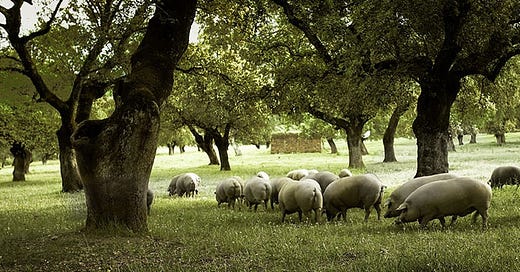



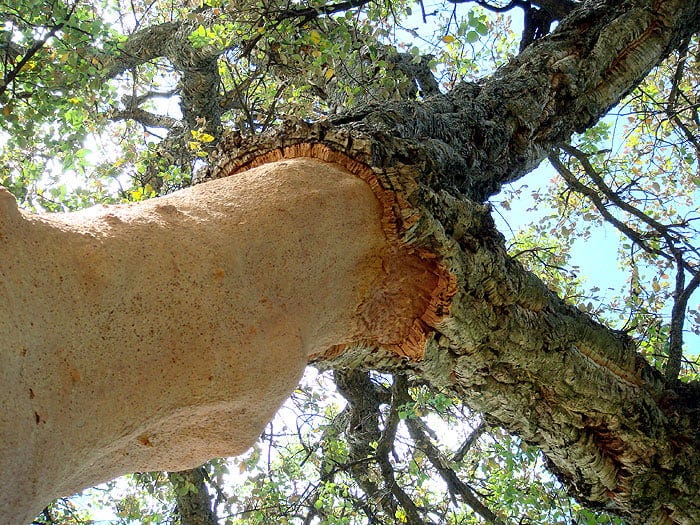
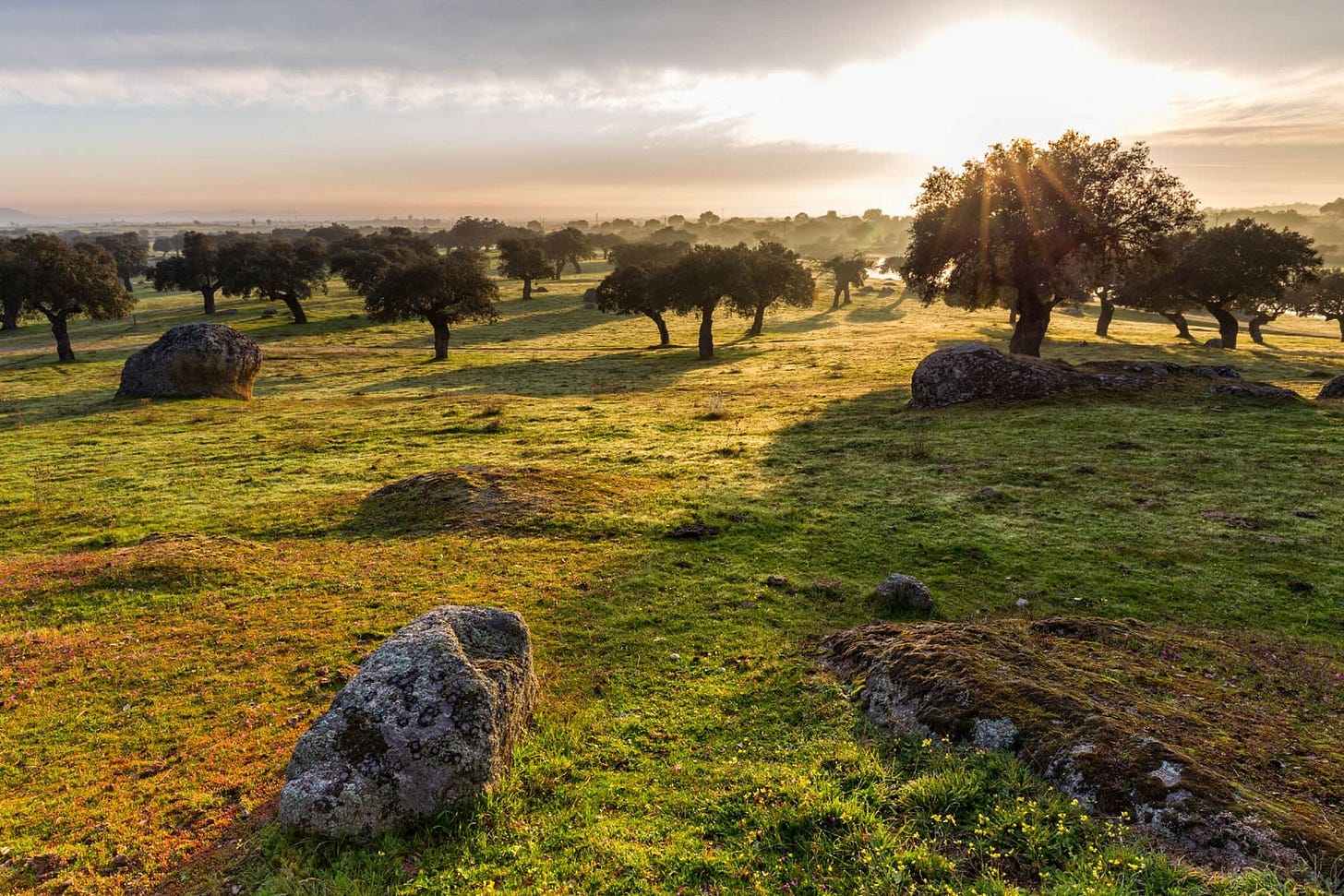
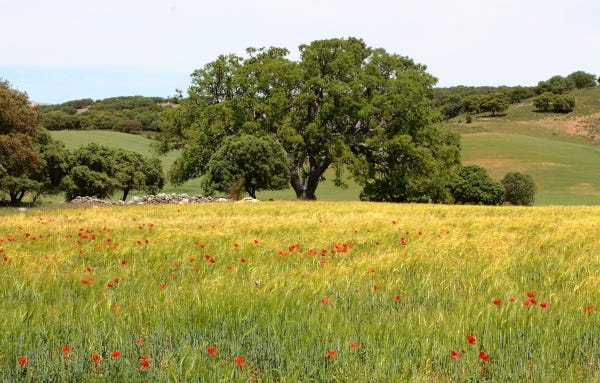


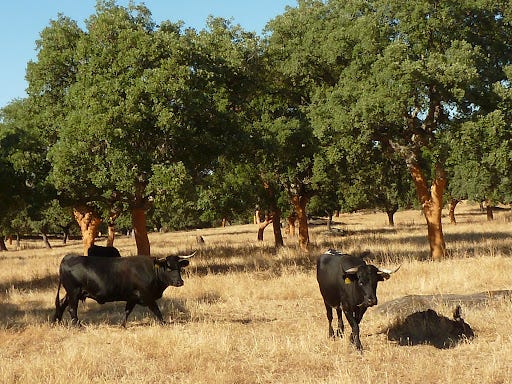
Thanks for this one! I love these deep-dives.
One small note: you mention a Reconquest from "the Moors" (la reconquista or reconquesta). There was no Reconquest in history, it only exists in the white supremacist imaginary of the Spanish state (and broader European historiography). When Muslims conquered most of the Iberian peninsula, Spain didn't exist, and unified Catholic rule didn't exist. Most of the peninsula's population stayed, with Muslim aristocratic and clerical classes replacing the Germanic Arian and Catholic ruling classes that had previously divided up the peninsula after the overthrow of Roman authority. Several centuries later, Christian monarchs began a genocidal process, not just replacing the contemporary ruling class of the peninsula, but slaughtering, forcibly converting, or enslaving all of the Muslim, Jewish, and non-Catholic Christians of the peninsula. There was no "Reconquest" because those institutions and peoples had never held power over the whole peninsula, and because it was a genocide that greatly informed the invention of the white race in the Iberian experience (in parallel to how the English invented the white race in part through their genocidal campaigns in Ireland).
And the idea of being Spanish as an ethnicity, uniform language, or national identity didn't arise until several centuries after that. Additionally, the fascists in the Spanish Civil War frequently used "Reconquista" imagery, whereas the antifascists (Socialists and Communists) sabotaged the possibility of Moroccan independence, which national liberation organizations and Catalan anarchists were trying to coordinate... Racists today also talk about a Reconquest and "Moors", so in general it's just best not to feed into that mythology.